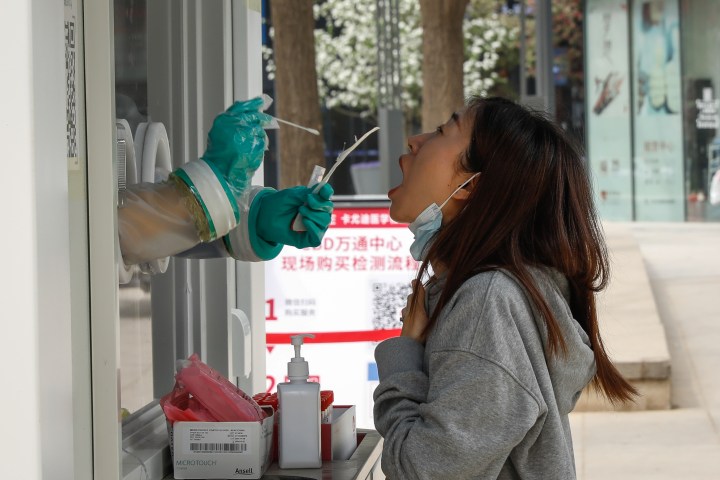COVID-19
Shanghai eases lockdown in some areas despite record Covid-19 infections

SHANGHAI, April 11 (Reuters) - China's financial centre of Shanghai started easing its lockdown in some areas on Monday despite reporting a record of more than 25,000 new Covid-19 infections, as authorities sought to get the city moving again after more than two weeks.
Pressure has been mounting on authorities in China’s most populous city, and one of its wealthiest, from residents growing increasingly frustrated as the curbs dragged on, leaving some struggling to find enough food and medicine.
City officials announced on Monday morning that they were grouping residential units into three risk categories as a step towards allowing “appropriate activity” by those in neighbourhoods with no positive cases during a two-week stretch, adding that district authorities would publish further details.
Among the first districts to release lists were the industrial area of Jinshan on Shanghai’s southwestern edge and the central area of Jing’an, which posted the names of residential sites still in high- and medium-risk categories.
While videos published by local media showed that most residents in areas earmarked for easing were still locked in and waiting to be notified of next steps by their neighbourhood committees, they also showed some people trickling out from their homes onto the streets.
“It’s good to be out finally, although there’s nowhere to go,” a resident who gave her surname as Qin told Reuters.
The step provides some relief for many cooped up for more than three weeks in the battle against China’s biggest outbreak since the coronavirus was first found in central Wuhan in late 2019. Read full story
City official Gu Honghui said Shanghai was divided into 7,624 areas that were still sealed off, with a group of 2,460 now subject to “controls” after a week of no new infections, and 7,565 “prevention areas” to be opened after two weeks without a positive case.
Those in “prevention areas” who move around their neighbourhoods must observe social distancing and could be sealed off again if there are new infections, Gu added.
NO CHOICE
Some social media users criticised the easing move as risky at a time of record new daily cases, but others said Shanghai had no choice.
Complaints about controls continued, with some in the city’s Xuhui district telling Reuters that neighbourhood committees had put locks and bicycle chains on their front doors from late Sunday to confine them to their homes.
China’s zero-tolerance approach to Covid-19, prescribing central quarantine for anyone testing positive even in the absence of symptoms, is increasingly strained by the highly infectious, though less deadly, Omicron variant.
The policy has halted nearly all international travel and is taking a growing economic toll as cities impose curbs, with southern Guangzhou and eastern Ningbo the latest to do so, even as other countries try to live with the disease.
On Monday, the European Chamber of Commerce in China said it sent a letter to China’s State Council, or cabinet, describing the challenges for firms because of the recent Covid-19 prevention measures and urging the country to review the policy.
Data also showed that China’s auto sales plunged in March as curbs to rein in Covid-19 outbreaks took a toll, with Tesla Inc TSLA.O among automakers feeling the pain of limits on production.
Still, the “dynamic clearance” policy remained Shanghai’s “best option”, said Liang Wannian, who heads a National Health Commission panel on Covid-19.
It was misleading to view Omicron as “big flu”, and lowering China’s guard would expose its huge elderly population to risk, especially as the virus mutates, Liang said.
“If we lie flat, the epidemic would just be a disaster for these kinds of vulnerable people,” the ruling Communist Party’s official People’s Daily quoted Liang as saying, making use of a popular term for doing the minimum.
Shanghai added 25,173 new asymptomatic infections on Sunday, up from 23,937 the previous day, although symptomatic cases edged down to 914 from 1,006.
By David Stanway
(Reporting by David Stanway, Engen Tham and the Shanghai and Beijing newsrooms; Editing by Clarence Fernandez, Tony Munroe, Raju Gopalakrishnan and Alex Richardson)
"Information pertaining to Covid-19, vaccines, how to control the spread of the virus and potential treatments is ever-changing. Under the South African Disaster Management Act Regulation 11(5)(c) it is prohibited to publish information through any medium with the intention to deceive people on government measures to address COVID-19. We are therefore disabling the comment section on this article in order to protect both the commenting member and ourselves from potential liability. Should you have additional information that you think we should know, please email [email protected]"





 Become an Insider
Become an Insider